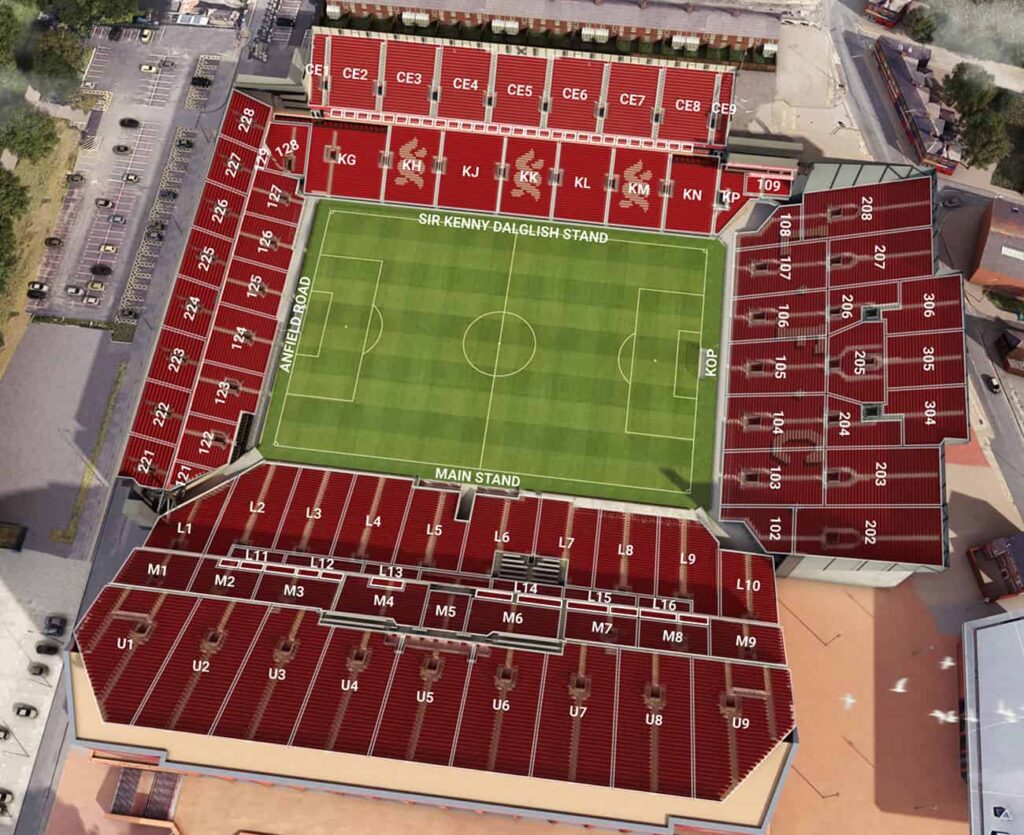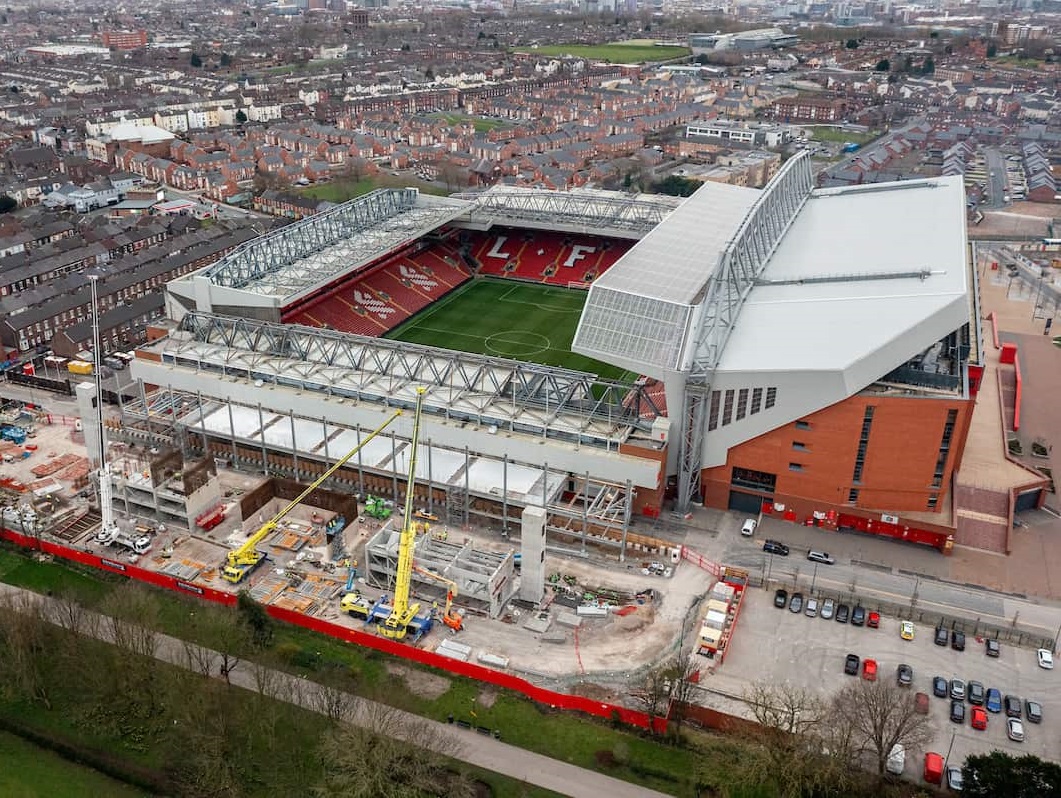Anfield is a football stadium in Anfield, Liverpool, Merseyside, England, which has a seating capacity of 53,394, making it the seventh largest football stadium in England. It has been the home of Liverpool F.C. since its formation in 1892. It was originally the home of Everton from 1884 to 1891, before moving to Goodison Park after a dispute with the club’s chairman.
The stadium has four stands: the Spion Kop, the Main Stand, the Sir Kenny Dalglish Stand and the Anfield Road End. The record attendance of 61,905 was set for a match between Liverpool and Wolverhampton Wanderers in 1952. The ground was converted to an all-seater stadium in 1994 as a result of the Taylor Report, which reduced its capacity.
Two stadium gates are named after former Liverpool managers: Bill Shankly and Bob Paisley. Both managers have been honored with statues outside the stadium: Shankly’s presented in 1997 by the Kop Stand and Paisley’s in 2020 by the Main Stand. The ground is 2 miles (3 km) from Liverpool Lime Street railway station. In 2002 it was proposed to replace the stadium with a new one in adjacent Stanley Park, but after the takeover of Liverpool F.C. by Fenway Sports Group in 2010 it was made clear that this would not happen.
Construction of an extension to the main stand began on 8 December 2014. One of the largest single seated stands in European football, this extension opened to the public on 9 September 2016, increasing the stadium’s capacity to 53,394. The Anfield Road Stand is currently undergoing redevelopment to increase the stadium’s capacity to around 61,000. It must be completed in time for the 2023-24 season.
| Built In: | 1884 |
| Capacity: | 53,394 |
| Home Teams: | Liverpool FC |
| Ground Size: | (110.5 yd × 74.4 yd) |
Anfield Stadium History
The stadium is named after the surrounding area, Anfield. The word originated from the combination of Old and Middle English words, meaning “a field on a slope”. Anfield, and its deviations, have been associated with the area since at least 1642. It has been suggested that the name is related to the influx of Irish into the expanding town in the 1850s, and was associated with Anfield, on the outskirts of New Ross. County Wexford, Ireland. Opened in 1884, Anfield was originally owned by John Orrell, a minor landowner who was a friend of Everton F.C. member John Houlding. Everton, who previously played at Priory Road, needed a new venue due to the crowd noise on match days.
Orrell lent the field to the club in exchange for a small rent. The first match at the ground was between Everton and Earlestown on 28 September 1884, which Everton won 5-0. During Everton’s tenure at the stadium, stands were erected for some of the more than 8,000 spectators who regularly attended matches, although the ground could and occasionally did hold around 20,000 spectators. The ground was considered to be of international standard at the time, having hosted the British Home Championship game between England and Ireland in 1889. Anfield’s first league match was played on 8 September 1888, between Everton and Accrington FC. Everton rapidly improved as a team and became Anfield’s first league champions in the 1890-1891 season.
In 1892, negotiations to buy the Anfield land from Orrell turned into a dispute between Houlding and Everton F.C. committee on how the club worked. Events culminated in Everton’s move to Goodison Park. Houlding was left with an empty stadium and decided to form a new club to occupy it. The new team was called Liverpool F.C. and Athletic Grounds Ltd, and the club’s first game at Anfield was a friendly played in front of 200 people on 1 September 1892, against Rotherham Town. Liverpool won 7-1.
Stadium Capacity
Anfield Stadium has a seating capacity of 53,394.
Anfield Stadium Seating Plan

Notable Events & Records
The highest recorded attendance at Anfield is 61,905, for Liverpool’s match against Wolverhampton Wanderers in the FA Cup fifth round, on 2 February 1952. The lowest recorded attendance at Anfield was 1,000 for a match against Loughborough on 7 December 1895. The highest average attendance of 53,112 was set for the 2016-17 season.
Liverpool did not lose a league game at Anfield during 1893–94, 1970–71, 1976–77, 1978–79, 1979–80, 1987–88, 2008–09, 2017–18, 2018–19, 2019–20, and seasons 2021-22. Liverpool’s longest unbeaten run at home spanned from January 1978 to January 1981, a period spanning 85 games, in which Liverpool scored 212 goals and conceded 35. The club’s longest unbeaten home run in the league is 68 games, which occurred from April 2017 through January. 2021. Liverpool’s worst losing run at Anfield is six games in 2020-2021 with games played behind closed doors during the COVID-19 pandemic. The most consecutive league wins at Anfield is 24, this is the longest streak in the history of the English top flight. It was achieved during the 2018-19 and 2019-20 seasons.
Upcoming Events
Not Yet.
Parking
If you are visiting Anfield, you can park in the Sir Kenny Dalglish Stand car park. The entrance is on Walton Breck Road, L4 0RE. Parking here is free and the area is manned by members of our security staff.

